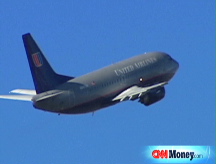Discount fliers: Your days are numbered
Continental announces drastic service reductions nationwide. Other carriers could axe discount flights to Orlando, Cancun, Honolulu, experts say.
NEW YORK (CNNMoney.com) -- As the battered airlines cut flights to save on fuel-related costs, passengers can bid bon voyage to discount flights to sunny vacation destinations like Florida, experts say.
Continental has eliminated service to airports big and small all across the nation, meaning that fliers will have less options when booking air travel.
"What airlines want to do is cut out the flights where they're making the least amount of money," said David Stempler, president of the Air Travelers Association, a passenger advocacy group.
The money-losing airline industry is scrapping its least-fuel efficient flights in step with the dramatic increases in energy costs.
The Air Transport Association estimates that fuel costs for the industry will total $61.2 billion in 2008, up nearly 50% from $41.2 billion in 2007, and more than quadruple the 2002 total of $12.7 billion.
On Thursday, Continental Airlines (CAL, Fortune 500) said it is reducing flights across the board. It cut flights though hubs like Houston by nearly 8% in the fourth quarter, along with a 3% reduction through its Newark hub, a 13% reduction to flights through Cleveland and a 21% cut to Guam. The airline also said it was shutting down service to non hub destinations like Sarasota and Tallahassee Florida, as well as Oakland and Palm Springs in California, among other locations.
JetBlue Airways (JBLU), Southwest Airlines (LUV, Fortune 500) and AirTran Airways (AAI) are among the airlines that currently offer cut-rate flights to Florida destinations such as Orlando, home to Disney World and other amusement parks. But airline analysts said that Florida's status as a top discount destination for families is in danger. Airlines are having difficulty keeping prices low for flights in the intensely competitive Florida market especially as fuel prices keep rising.
"Leisure markets, particularly Florida and other family-oriented destinations, will feel the pain due to the price sensitivity of the typical consumer," said Joe Schwieterman, a transportation expert at DePaul University in Chicago.
Analysts said that other discount destinations, such as Las Vegas, Cancun and Honolulu, could become the next casualties of the dramatic increases in jet fuel prices.
"As a long haul leisure destination, Hawaii is an extremely fuel intensive trip," said Schwieterman, noting that the escalating fuel cost of the trans-Pacific flight makes it increasingly difficult to keep fares low.
Nonetheless, JetBlue spokesman Bryan Baldwin said his airline has no plans to get rid of discount flights. Southwest spokeswoman Brandy King said her airline has no plans to cut service to Florida and California.
Airlines have continually raised -- or tried to raise - fares these year to make up for the fuel costs. In the latest move on Wednesday, AMR Corp.'s (AMR, Fortune 500) American Airlines increased its fuel surcharge by $20 roundtrip. American had raised fares just days earlier -- an increase that was matched by Delta Air Lines Inc. (DAL, Fortune 500) and UAL Corp.'s (UAUA, Fortune 500) United Airlines and Continental - but retracted the increase on June 9.
Some airlines are also charging extra for benefits that used to come for free, such as luggage services and food. On Thursday, United said it would start charging $15 for the first checked bag in August. This follows an earlier announcement from American, which plans to begin charging $15 for the first checked bag this month.
To maximize fuel efficiency, airlines are trying to fill their planes as much as possible by cutting capacity through reducing the overall number of flights. As part of this capacity-cutting, Continental on June 5 said it will ground 67 airplanes and reduce domestic flights by up to 11.8% in fiscal year 2009, in addition to eliminating about 3,000 jobs. On June 4, United said it was grounding 100 airplanes and reducing domestic flights by up to 18% in 2009, in addition to cutting up to 1,600 jobs.
The major hubs aren't facing closure, though service is getting squeezed.
Of the major hubs in the United States, the Cincinnati/Northern Kentucky International Airport could be the next hub to see a drastic tightening of service, say analysts. This is because Delta's Cincinnati hub is heavily reliant on small inefficient jets, said Michael Boyd, president of the Boyd Group, a consulting firm in Colorado.
"Cincinnati is very problematic because it is 70% operated with regional cabin jets," said Boyd. "Most of those are 50-seaters and they're not economic anymore. As it stands now, that connecting hub is not viable for Delta."
This means that Cincinnati will probably lose some "spokes in the hub," meaning direct flights to other cities, said Boyd. But he downplayed the impact as not being too dramatic to the average traveler or local resident.
"Cincinnati continues to be an important hub for us," said Delta spokeswoman Susan Elliott, noting that her airline has been reducing domestic capacity since last year. "The fares in Cincinnati essentially reflect the cost of doing business there."
The most serious impact, thought not perhaps as widespread, will be felt at small regional airports located in rural areas or near major hubs in big cities.
Air service to dozens of small regional airports is completely drying up this year, according to industry sources. Some 37 airports will lose service this year, including far-flung spots in Alaska and Montana, as well as cities like Trenton, N.J. and Portsmouth, N.H. that are close to heavily-trafficked hubs like Philadelphia and Boston. This is in addition to the 59 airports that lost service in 2007, more than half of them in Alaska.
"[The airlines] are looking at where they're making the least amount of money," said David Castelveter, spokesman for the Air Transport Association. "Many times, it's the small communities." ![]()


